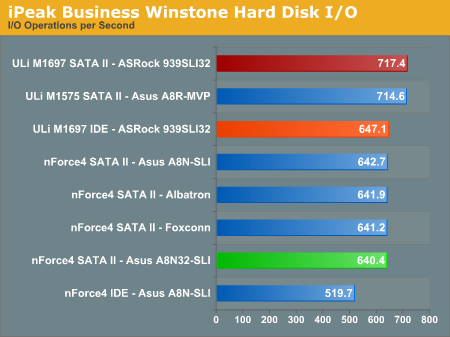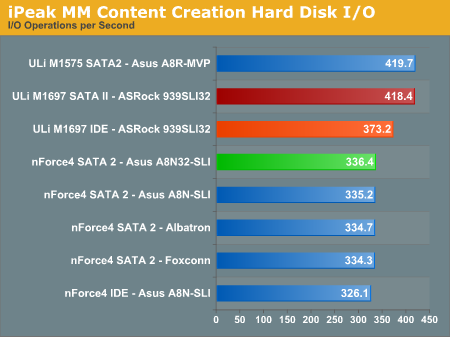ASRock 939SLI32-eSATA2: ULi Dual x16 SLI
by Gary Key on March 2, 2006 12:15 PM EST- Posted in
- Motherboards
Disk Controller Performance
With the variety of disk drive benchmarks available, we needed a means of comparing the true performance of the wide selection of controllers. The logical choice was Anand's storage benchmark first described in Q2 2004 Desktop Hard Drive Comparison: WD Raptor vs. the World. The iPeak test was designed to measure "pure" hard disk performance, and in this case, we kept the hard drive as consistent as possible while varying the hard drive controller. The idea is to measure the performance of a hard drive controller with a consistent hard drive.
We played back Anand's raw files that recorded I/O operations when running a real world benchmark - the entire Winstone 2004 suite. Intel's iPEAK utility was then used to play back the trace file of all I/O operations that took place during a single run of Business Winstone 2004 and MCC Winstone 2004. To try to isolate performance differences to the controllers that we were testing, we used the Maxtor MaXLine III 7L300S0 300GB 7200 RPM SATA drive in all tests. The drive was formatted before each test run and a composite average of 5 tests on each controller interface was tabulated in order to ensure consistency in the benchmark.
iPeak gives a mean service time in milliseconds; in other words, the average time that each drive took to fulfill each I/O operation. In order to make the data more understandable, we report the scores as an average number of I/O operations per second so that higher scores translate into better performance. This number is meaningless as far as hard disk performance is concerned, as it is just the number of I/O operations completed in a second. However, the scores are useful for comparing "pure" performance of the storage controllers in this case.
With the variety of disk drive benchmarks available, we needed a means of comparing the true performance of the wide selection of controllers. The logical choice was Anand's storage benchmark first described in Q2 2004 Desktop Hard Drive Comparison: WD Raptor vs. the World. The iPeak test was designed to measure "pure" hard disk performance, and in this case, we kept the hard drive as consistent as possible while varying the hard drive controller. The idea is to measure the performance of a hard drive controller with a consistent hard drive.
We played back Anand's raw files that recorded I/O operations when running a real world benchmark - the entire Winstone 2004 suite. Intel's iPEAK utility was then used to play back the trace file of all I/O operations that took place during a single run of Business Winstone 2004 and MCC Winstone 2004. To try to isolate performance differences to the controllers that we were testing, we used the Maxtor MaXLine III 7L300S0 300GB 7200 RPM SATA drive in all tests. The drive was formatted before each test run and a composite average of 5 tests on each controller interface was tabulated in order to ensure consistency in the benchmark.
iPeak gives a mean service time in milliseconds; in other words, the average time that each drive took to fulfill each I/O operation. In order to make the data more understandable, we report the scores as an average number of I/O operations per second so that higher scores translate into better performance. This number is meaningless as far as hard disk performance is concerned, as it is just the number of I/O operations completed in a second. However, the scores are useful for comparing "pure" performance of the storage controllers in this case.












46 Comments
View All Comments
Gary Key - Saturday, March 4, 2006 - link
It works very well on this board with an Opteron. ;-)Kiste - Thursday, March 2, 2006 - link
In the past, Realtek has solved performance issues by reducing the number of buffers and disabling EAX effects without telling anyone. I hope someone will have a really good look at these integrated audio solutions one day, one that isn't just FPS and CPU utilization.
Gary Key - Thursday, March 2, 2006 - link
To date with the HD Codecs, Realtek has not decreased the buffers nor have we noticed changes in EAX2 output except for the positive. It is a very subjective area to comment on but in BF2 I like the sound quality of the 1.29 drivers better but Serious Sam II seems to have improved a great deal in the 1.30 and 1.31 drivers. While the on-board audio solutions are still lacking in most areas compared to the add-in solutions at least the manufacturers (board/chipset) are trying to improve quality in this area instead of pumping out the same old AC97 codecs. If it were not for the cost I think we would have seen several additional Audigy-SE solutions on the motherboards by now and even possibly an improved offering from Creative. While the A-SE is an older chipset it does offer better performance and audio quality in gaming than the current HD codecs from Realtek, C-Media, ADI, and SigmaTel. I really thought the VIA Envy24 series would have had greater market penetration on the motherboards but one can only speculate as to why this never happened. ;->
tjpark1111 - Thursday, March 2, 2006 - link
is it just me, or does this thing have a 20-pin power connector. ?!?!?!??!???kelim - Thursday, March 2, 2006 - link
Yes, the board does in fact use a 20-pin power connection. If you have a 24-pin PSU, this shouldn't be a problem, since most are 20+4-pin, meaning you can detach the extra 4 pins and only use the ones you need. Either that, or the uneeded pins will hang off the side.Gary Key - Thursday, March 2, 2006 - link
You are correct, it is a 20-pin ATC connector as stated in the article. I was surprised also and did a double take after removing it from the box. :)dab - Thursday, March 2, 2006 - link
It says that this motherboard supports ddr2,"(4) x DIMM, max. 4GB, DDR2 400/333/266, non-ECC, un-buffered memory..."
Is this a joke? There's no 240pin slots on that board, only on the riser (which is not included). s939's IMC doesn't support this either..
Am I mistaken?
Gary Key - Thursday, March 2, 2006 - link
I was just changing that to DDR, sorry about the mistake. The AM2 daughter card will have slots for DDR2 memory.
Puddleglum - Thursday, March 2, 2006 - link
The figure is noteworthy, but it's actually the only Firewire 800 test result I can find in AT's reviews.Gary Key - Thursday, March 2, 2006 - link
I know we only have it in a recent review and probably should drop it. I keep hoping Firewire 800 will be implemented on the higher end boards or those designed for HTPC life. :) However, it appears to be a dead-end option at this point and the technology itself seems to be going away without a fight.